DACF Home → Bureaus & Programs → Maine Natural Areas Program → Communities, Plants, and Animals → Invasive Plants → Burning Bush
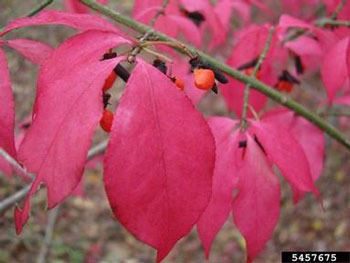 Burning bush fall stem with red leaves and berries. Leslie J. Mehrhoff, University of Connecticut, Bugwood.org
Burning bush fall stem with red leaves and berries. Leslie J. Mehrhoff, University of Connecticut, Bugwood.org
Burning Bush
(Winged euonymus)
Euonymus alatus
2019 Status in Maine: Widespread. Severely Invasive.
Description: Perennial, deciduous shrub, broadly branched, up to ~15' tall, forms dense thickets. Stems frequently have corky "wings." Leaves: Simple, opposite, roughly elliptical, tapered at both ends, usually 1-2" long, finely toothed. Vivid red fall color. Flowers: Small (~¼"), 4-petaled, light yellow to light green, in small clusters coming off the twig on 1-3" stems. Blooms in late spring. Fruit: In early fall, a capsule of red-orange seed surrounded by two purple fleshy coverings which split open. Fruit may remain on plant into the winter.
Native range: Northeastern Asia. How arrived in U.S.: As an ornamental.
Reproduction: By seed and vegetatively. The fruit is eaten and dispersed by birds. There is currently no data on seed banking. Plants can expand vegetatively from root sprouts, especially if damaged.
Habitat: Forests, forest edges, old fields, open areas. Shade-tolerant, will germinate, grow, and reproduce under full canopy. Tolerant of moist to well-drained soil.
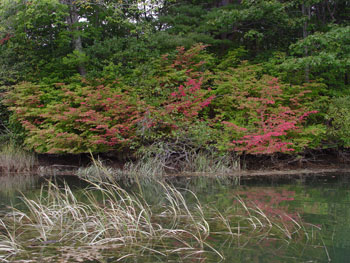 Burning bush in the woods along a stream
Burning bush in the woods along a stream
Similar native species: Several heath shrubs (blueberries, huckleberry) turn bright red in fall but these lack corky wings on branches and have alternate, usually entire leaves.
Similar non-native species: European spindle-tree (E. europaeus) has pink seed coverings over its reddish seeds, and has less oval, stouter leaves. Wintercreeper (E. fortunei) looks similar but is usually a climbing vine and is infrequently naturalized in New England. Japanese barberry can turn red in fall but has leaves in alternate nodes along the stem and sharp spines at the base of leaves. None of these have corky wings on the twigs like burning bush.
Documented Ecological Impacts
- Burning bush is fully shade tolerant and thus can easily spread into forests forming dense thickets that shade out native plants. (Winged Euonymus Fact Sheet. Morris Arboretum of the University of Pennsylvania. 2011)
- The dense shade and dense, tightly matted root system of burning bush makes it nearly impossible for other species to grow under it. (Burning Bush Fact Sheet, Skidmore College Crandall Park Trees)
- High white-tailed deer populations can promote establishment and spread of burning bush, as they preferentially feed on native vegetation. (Fryer, J.L. 2009. Euonymus alatus. In: Fire Effects Information System. U.S. Department of Agriculture, Forest Service)
- Spider abundance and diversity is greater in areas with native shrubby vegetation than in areas with burning bush. (Roberson, E., & Cipollini, D. (2015). Effects of Winged Burning Bush (Euonymus alatus), Management Strategy, and White-tailed Deer (Odocoileus virginianus) on Spider Assemblages. Wright State University, Biological Sciences Faculty Publications 557)
Fact Sheets and Identification Links
- Purdue University Extension, Indiana, Identification Video (2:30)
- Vermont Invasives Fact Sheet
- Go Botany page for Euonymus alatus
Control Methods
Small plants and seedlings may be pulled up by the roots when soil is moist; larger plants can be cut, but re-sprouting will occur.* Persistent cutting or mowing multiple times during the growing season over several years may kill the plant, but diligence is required. Mowing can prevent seedlings from establishing. Herbicides† are effective as foliar applications (glyphosate solution) or cut-stump applications (glyphosate or triclopyr solution applied immediately after cutting except in early spring).
* Correctly dispose of all plant parts↵ † Follow all label directions when using herbicides↵Control Technique Video Demonstrations
- No appropriate control videos found
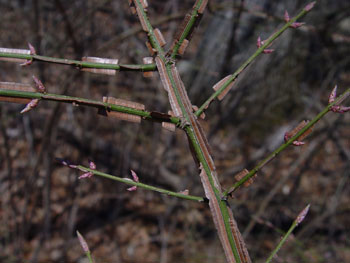 Burning bush stem with corky wings
Burning bush stem with corky wings
Please email invasives.mnap@maine.gov if you have questions about invasive species in Maine
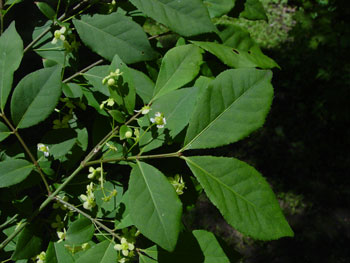 Burning bush stem with flowers
Burning bush stem with flowers
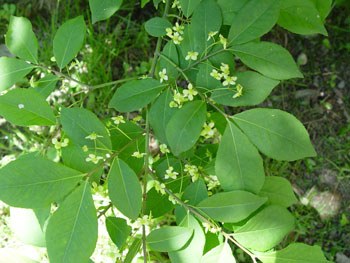 Burning bush stem with flowers
Burning bush stem with flowers